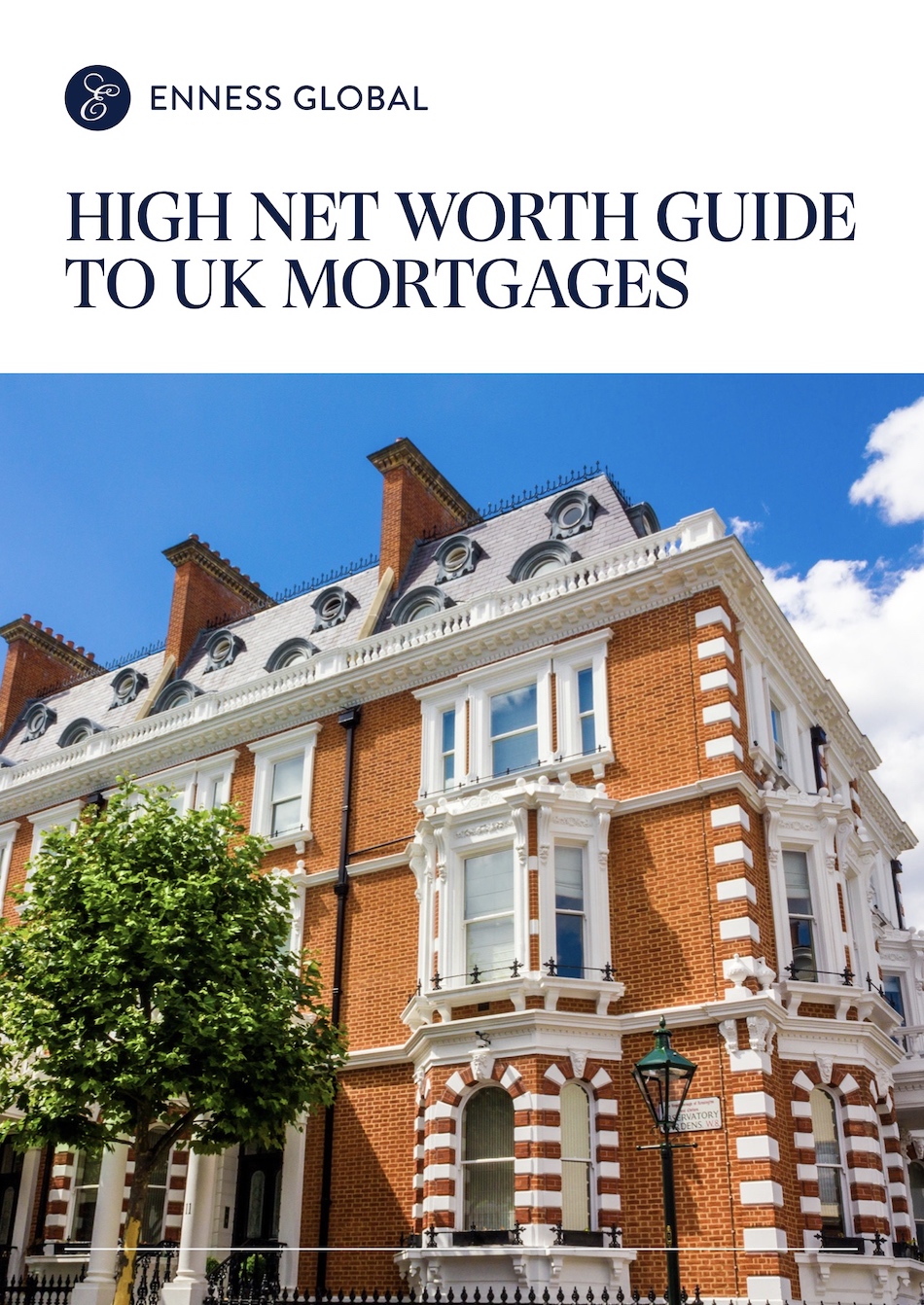Large International Buy-to-Let Mortgages in Dubai
Many Emirati residents (whether UAE citizens or expats) consider large buy-to-let mortgages in the UK. These investments are often very attractive - demand for rental property continues to grow, especially at the top of the market for prime and high-value rentals. However, in recent years, the UK government and regulatory authorities (Prudential Regulation Authority) have made changes to protect market integrity and reduce risk. This means that loan to value ratios are lower and it is possible to borrow less then before, and affordability tests are more stringent than they were previously. There have also been changes to the tapered tax relief for landlords.
Summary
When it comes to million-pound-plus buy-to-let mortgages, standard finance packages are usually inflexible. In many cases those looking for a buy to let mortgage in Dubai for the UK find off-the-shelf packages unworkable from both a terms and price perspective – here, a mortgage tailored to your requirements and financial situation will make all the difference. Enness will effectively build a one-of-a-kind mortgage for you. You will benefit from a large buy-to-let mortgage that is advantageous considering your income, assets, net worth and any requirements you have in terms of lender preferences, terms and flexibility.
Many high-street banks have backed away from offering large buy-to-let mortgages in recent years, especially for non-UK residents. However, there are still some great offers to be had through niche and alternative lenders, who are increasingly able to offer the most competitive conditions and rates for non-residents.
Enness’ specialists are experts in brokering large buy-to-let mortgages in the UK for Emirati nationals, expats based in the UAE and residents of the MEA region. With access to more than 500 lenders, your broker will assess your global assets and revenue streams to understand which lenders will offer the best rates and terms that will meet your requirements. They will also assess how best to present your case and how to reduce your overhead mortgage costs as much as possible while maximising what you can borrow as a non-resident.
Applying for a Large Buy-to-let Mortgage in Dubai as a Non-UK Resident
Traditional Buy-to-Let Mortgages
To understand what the best mortgage will be for you, you will need to understand what your requirements and objectives are for a large buy-to-let mortgage in the UK. For example, do you want to acquire new investment property or refinance an existing buy-to-let asset? Do you need a long-term financing arrangement, or are you planning to release funds from this property in the short to medium term? Ultimately, there are no right or wrong answers and whatever your objectives, there will be a mortgage available. However, your plans will influence which lenders it is best to approach for lending and what type of large buy-to-let mortgage is going to be best suited to your needs. As a non-UK resident, Enness will also be thinking about how to best present your case to lenders and what will give them confidence – your plans for your property will play into how your broker does this.
Many borrowers of buy to let mortgages in Dubai and the MEA region have property portfolios in the UK which generate rental income. In most cases, you will probably want to cover your buy-to-let mortgage payments with the income generated through the rental of the property. However, it’s important to note that most of the UKs mainstream lenders will classify rental income generated through your other buy-to-let properties as “uncertain.” Essentially, this means you can’t use other rental income as a basis through which lenders calculate affordability for your new buy-to-let property purchase. If you have non-rental income, you may find that mainstream lenders can offer you competitive deals but borrowing as a non-UK resident if you live in Dubai or the MEA region as a citizen or expat can be challenging. For this reason, most MEA-based borrowers prefer to opt for bespoke buy-to-let mortgages in Dubai which offer significantly more flexibility.
Bespoke Buy-to-Let Mortgages
Whatever your plans for your buy-to-let property, it is essential that you find the right financing vehicle through which to undertake your UK property investment. Usually, a tailored buy-to-let mortgage will be much better suited to your needs than an off the shelf package offered by a mainstream lender in the UK. Mainstream lenders can struggle to take the strength of your financial situation and net worth into consideration, especially if you have multi-currency income, various revenue streams and global assets.
Enness has access to all the specialist large buy-to-let lenders on the market. These lenders are also readily able to lend to Dubai-based borrowers, British expats and residents of MEA countries. Specialist lenders will be able to take a more holistic view of your background than high street lenders. They can also consider more of your cumulative wealth and global assets as well as your short, medium and long-term income streams – regardless of where these are and what currency they are in.
Using Enness’ contacts and experience brokering finance for EMA-based borrowers, you will be able to secure a large buy-to-let mortgage in the UK by cross charging assets, releasing equity elsewhere in your portfolio and prepaying interest. All of these will have a positive impact on your interest rate and the terms of your arrangement.
Purchasing Personally or Through a Company
Back in 2017, the UK government announced that it planned to gradually restrict the amount of tax relief property investors could deduct against mortgage interest on a buy-to-let mortgage. This phasing out was completed in 2021.
As a result of these changes, landlords can no longer claim any tax relief on their buy-to-let mortgages. The rules apply to individual property owners rather than businesses that own property through corporate structures.
Many EMA-based borrowers buy and hold property through corporate entities, but these changes are worth bearing in mind, especially if you are buying your first buy-to-let property in the UK and planned to do so in your own name.
Enness' team is always delighted to walk you through your options and explain how purchasing a buy-to-let property through a corporate structure in the UK works. As always, getting independent and expert advice from your advisers on the best structure is imperative to streamlined and efficient property purchases, especially in cross-border transactions. There are a wide number of options and avenues available for Dubai-based borrowers (or residents of MEA countries) when it comes to financing vehicles. Enness’ brokers will be able to source and negotiate mortgages that meet any of your requirements in this respect.
If you have any questions, would like to learn more about securing a large buy-to-let mortgage in the UK as an expat or non-resident, please get in touch. A member of Enness’ team will be delighted to speak with you about your options and cover any questions you have.
Understanding Regulated and Unregulated Buy-to-Let Mortgages
There are two specific types of buy-to-let property finance: regulated and unregulated mortgages. Both are relevant to non-UK based borrowers, especially those from the MEA region who may purchase a property as a non-resident but use the residence in some respect for personal use.
A regulated buy-to-let mortgage (sometimes referred to as a family buy-to-let) concerns the purchase of a property that:
- You will occupy at some point as an owner
- You plan to let to a family member
Many EMA-based borrowers rent property to family in the UK (e.g., children living or studying in the UK, extended family), or buy rental property that you will also occupy for some periods of time. These types of purchase fall into the regulated buy-to-let category. If you are an expat based in the UAE or in an EMA country, you might also find you will be looking at a regulated buy-to-let property if you are purchasing a home that you plan to live in at some point in the future.
Unregulated buy-to-let mortgages refer to properties that you will rent out to third parties.
The distinction between regulated and unregulated buy-to-let mortgages is important because many borrowers think they can opt for an unregulated buy-to-let mortgage, but they actually need to consider a regulated mortgage. In essence, regulated mortgages have different rules around affordability and how lenders will look at income, how much you can borrow and so on.
These buy-to-let mortgages – especially for prime property and high-value purchases – are provided by high street banks, private banks or niche lenders. Private banks and niche lenders tend to be able to offer more competitive rates and terms to non-resident borrowers, although sometimes offers from mainstream lenders may be worth exploring.
Large UK Buy-to-Let Mortgages for EMA-based Borrowers
How Lenders Will Assess You
UK buy-to-let mortgage applications focus on affordability and risk, with lenders assessing carefully how you will make repayments and how easy it is for you to do so. Lenders calculate the affordability in different ways, especially as a non-resident, so there is no way to definitively calculate how the whole market will view your application and what you will be able to borrow. Generally, high street banks have relatively limited risk appetites, but private banks and niche lenders are a little more flexible on this point.
Most lenders will look at your salary or income when determining affordability, however some will consider the rental revenue you will generate from the property and can take this into account in affordability calculations. Lenders normally want to see that the rental income covers the mortgage by a margin of at least 150%. They do this as a way to ensure that you can comfortably meet your mortgage payments in the event of a short-term vacancy. The standard rent cover is 150%; however, this will vary from lender to lender and can also be influenced by the fact you are a non-resident borrower.
While many buy-to-let Dubai-based investors are high-net-worth individuals with significant wealth and income, it is worth noting that many of the UK’s mainstream banks require that buy-to-let borrowers have a minimum income of at least the equivalent of £25,000. If you do not have UK income (aside from rental income) high street lenders can struggle to let you borrow.
Here, private banks and alternative lenders come into their own for EMA-based borrowers. These institutions differ from high street banks in that they are happy to lend to non-resident borrowers and can both understand and analyse ‘non-standard’ income and wealth e.g., global assets and multiple income streams. Enness may also be able to help you get a mortgage even if you have little income but significant assets and wealth.
Short-Term Trackers and Long-Term Fixed Rates
When it comes to the buy-to-let interest rates in the UK, there is something for everyone. Because the UK's base rates are low, short to medium-term fixed rates are in high demand. Some buy-to-let investors have even gone so far as to lock in their mortgage rate for longer than the typical five-year period to have more certainty in the future.
Tracker interest rates (which track base rates plus a fixed margin for the lender), have piqued the curiosity of resident and non-resident buy-to-let investors in recent years.
In the end, the rates you are offered for a large buy-to-let mortgage in the UK will be determined by what you can bring to the table in terms of your assets and wealth. The more liquid and consistent your income (whether via a salary or revenue from business interests or other investments) is, the more options you will have in terms of a mortgage and lenders. If you are an established property investor with a UK property portfolio worth tens of millions of pounds, you'll have even more alternatives. The substantial cash flow and utilising of paid-up properties for security or remortgaging are two possibilities if you have a large buy-to-let portfolio. Because average rental returns are much greater than mortgage interest rates, there is usually room to grow your assets and income.
Enness delivers the most competitive rates and terms on the market for Dubai-based and EMA-based borrowers, regardless of the size of your portfolio, financial background or net worth.
Size of The Property Portfolio
Managing a buy-to-let portfolio is relatively simple, as long as everything goes to plan all the time – however, things can always go awry, even if they are relatively minor. Lenders will want to know how you plan to deal with any issues that arise. If you are buying buy-to-let property in the UK and live in Dubai, the UAE or you are based in an EMA country, many lenders will prefer you work with a property management company.
While there is always a management fee to consider, managing properties from abroad is challenging, and mistakes can be costly and strain cash flow. Lenders often prefer non-resident borrowers who work with management firms to help them market the property quickly from a UK base if a tenant leaves, as a way to ensure the property remains vacant for as little time as possible between tenants.
How Much Can You Borrow for a Buy-to-Let Mortgage in Dubai?
The vast majority of Enness’ clients from Dubai and the EMA region are high-net-worth individuals looking for multi-million-pound mortgages. Not every lender will have an appetite for high-value buy-to-let mortgages or lending to non-residents. However, other lenders will gladly let you borrow, although many will not openly publicise their services, operating on an introduction-only basis instead.
In theory, there is no upper limit on what you can borrow for a buy-to-let property. However, you will need to have a logical plan and supply evidence that there is a rental demand for your property. The more you plan to rent your property for, the more lenders will look at the details and want to ensure that you will be able to rent it. How far this rental income will go to cover the mortgage will also be important.
It is critical to know which lenders to approach if you want a high-value buy-to-let mortgage as a Dubai-based borrower or if you reside elsewhere in the EMA region. However much you want to borrow, Enness will source and negotiate the best buy-to-let mortgage.
Large Buy-to-Let Lenders
As a non-resident borrower, if you want to borrow a significant amount for a buy-to-let property, you will likely be best served by private banks and niche lenders. Generally, they can better cater to non-resident buyers and offer more advantageous terms than high street banks, although it’s important not to overlook the latter altogether.
Traditional lenders such as high street banks can still offer very competitive buy-to-let mortgages, but only if you have a very plain-vanilla scenario. Generally, exploring borrowing from high street banks can be a viable option if you have sufficient income to cover mortgage repayments (excluding other rental income). If you have multi-currency income, exclusively generate income outside the UK, or have relatively little income but a significant net worth, borrowing from high street lenders can be challenging as a non-resident. However, as a consequence of Enness’ long-term relationships with many traditional banks, there is a greater degree of flexibility when instigating face-to-face negotiations, especially for non-resident borrowers if you have the right kind of background. While most multi-million-pound mortgages still tend to be the domain of private banks and niche lenders, other lenders are often worth exploring.
High Street Banks
High street banks in the UK are funded differently from private banks and alternative lenders. There is some degree of flexibility for bespoke arrangements for certain borrowers. However, there are restrictions on how much these banks can lend in most cases, especially if you are based in Dubai or the MEA region – even as an expat.
Specialist Lenders
Specialist lenders are a vital part of the UK mortgage market, and many non-resident borrowers get the best buy-to-let mortgages from these institutions. As with their private bank counterparts, specialist lenders can take a more rounded approach to non-resident borrowers – especially those with multiple income streams and global assets.
Private Banks
Private banks have become the first port of call for many non-resident buy-to-let mortgage applications, especially for non-resident buyers. Most private bank mortgage funding agreements are one of a kind, and you will benefit from a package that is tailored to your individual situation, finances, assets and structures. Comparing headline interest rates from private banks with high street bank mortgages is difficult – rates may be very slightly higher with a private bank. Still, a private bank mortgage will come with more flexibility, better terms and other advantages. This is always worth bearing in mind.
Private banks mortgages are extremely popular with high-net-worth individuals from the UAE and MEA region, especially if you are in the market for additional wealth management services. These lenders can offer extremely attractive, often subsidised, headline mortgage interest rates to tempt VIP borrowers who then become clients of the bank. In return for the best rates, many buy-to-let mortgage arrangements will also involve the transfer of additional investments to the bank’s asset management division.
Where other lenders can be focused on rigid underwriting and risk tests, private banks are usually more flexible. You will usually be able to put forward global assets and multiple income streams as collateral for a buy-to-let mortgage.
Most private banks do not publicise their services openly – especially for large buy-to-let mortgages. Borrowing from many of these institutions remains “invitation only”. Enness can approach private banks you would not be able to access through traditional contact routes.
Bridging and Short-Term Lenders
You may wish to acquire a buy-to-let property that you will develop or refurbish before renting it out. Here, bridging or short-term funding is often used to finance the cost of the work before you go on to remortgage the property at a higher value. Short-term finance can last between 24 hours and up to three years, depending on your needs.
If you want to pursue bridging finance before remortgaging your buy-to-let property, Enness’ team may suggest arranging the remortgaging deal at the same time as bridging finance. Doing so ensures repayment of the short-term finance as quickly as possible and re-bases the debt on a more traditional mortgage interest rate which is usually significantly cheaper.
International Banks
Many international banks will lend to expats and borrowers from Dubai, the UAE and MEA region. As with many high-value mortgages, most deals from these lenders are not promoted to the broader public, and introductions are essential. Enness’ brokers will always assess your situation and financing requirements to identify if an international bank or a local UK bank will be the best lender for you. Enness will then make full use of a network of more than 500 lenders to arrange the best buy-to-let mortgage funding for you.
Special Situations
Many of Enness’ clients in Dubai, the UAE and MEA countries have large buy-to-let property portfolios in the UK. A tailored buy-to-let mortgage will become more beneficial and necessary as your property portfolio grows. Whether you are considering your rental income, property values, or redevelopment, you will want to maximise what you can borrow while minimising your mortgage costs.
When Rental Income Doesn’t Cover Your Mortgage: Top Slicing
The buy-to-let mortgage lenders who consider rental income as part of their affordability calculations will have a set cover ratio. On average, this works out at around 150% (at the most basic, if your mortgage repayment is £1000 each month, the lender would need to see at least £1500 in monthly rental income).
Top slicing is used when there is a shortfall in rental income, and the lenders cover ratio is not met. The cover percentage varies from lender to lender. Some lenders can consider top slicing for non-residents, and others will not. Working with a broker is often the best (and sometimes the only) way to benefit from top-slicing if you are after this type of finance.
If you want to top slice, the lender will consider your personal income in addition to other factors such as rental income, demand for the property you wish to buy and then rent, and so on. Each lender will have a different calculation and way they view surplus income. The idea is that part of this surplus income would be committed to the repayment of monthly mortgage liabilities – effectively covering the rental income shortfall. However, there can be issues if you have an extensive portfolio as the lender may need to recalculate affordability, top-slicing included, for all properties you own.
Redeveloping Properties Before Renting Them
Short-term finance (usually known as bridging loans) is beneficial if you want to develop or build a property in the UK. Bridging loans can be more difficult to arrange as a non-resident, but they are a possibility and working with a broker usually makes the process infinitely easier. Your lender will usually release payments in stages for these kinds of projects. When pre-agreed milestones are met on the build or development, the lender will verify that the work has been carried out to plan and then release funds to finance the next stage of work. Staggering payments in this way means you won’t pay interest on all funds for the entire term of the loan, and at the same time, the lender’s risk is reduced if you don’t complete work on time or you run over budget.
What does this look like practically, and how is it advantageous to you?
Let’s say you have a non-resident mortgage on a property valued at £2 million that you later want to rent. You take out a bridging loan of £500,000 to cover redevelopment/building work to increase the property's value.
After the redevelopment/rebuild work, you’ve increased the value of your property to £3.2 million, essentially creating an additional value of £700,000. You refinance the property and use this new loan to pay off the original mortgage and the bridging loan. The new loan is based on the property’s new value after development. You can use any additional funds raised through the remortgage to reduce the LTV (thereby decreasing the headline interest rate) by retaining equity within the property or for other investments.
High-Value Buy-to-Let Property: Mortgages Over £3 million
Many Emirati and EMA-based borrowers’ approach Enness to broker three-million-pound-plus buy-to-let mortgages. Here, the best way to maximise what you can borrow and reduce headline interest rates is to utilise all your income streams and all assets. Usually, private banks and alternative lenders offer the best rates and terms here as high street banks can struggle to provide mortgages this large, especially to non-residents.
Often private banks or niche lenders can offer the best mortgages for rental properties and will request lower deposits if you transfer assets to the asset management division of the lender. As well as providing more flexibility than high street creditors, private banks and niche lenders will most likely be Enness’ first port of call for negotiations as a non-UK based borrower. This will be especially useful if you have multiple income streams outside the UK and assets dotted around the globe. Private banks and niche lenders are used to lending to high-net-worth individuals who reside abroad and are more flexible in their approach to underwriting and borrowing. Enness will approach these institutions to negotiate and build bespoke arrangements taking your current and future income, assets and plans into consideration.

Contact Enness
Whether you are thinking about buying your first buy-to-let property or if you are a professional landlord adding to your portfolio, give Enness a call today to discuss your situation in more detail. Enness’ expert team of buy-to-let mortgage brokers in Dubai will be able to advise you of your options and current rates on the market.
LET's TALK NOWHigh Net Worth Guide to UK Mortgages
The UK is home to one of the most liquid, competitive, and complicated mortgage markets in the world.
There are hundreds of mortgage providers who lend in the UK, from major international banks to niche building societies and alternative lenders. Each lender has their own specialisation and position in the market where they excel. They also have lending criteria, interest rates, processes and oddities which are specific to them.
The UK has a considerable number of lending channels. There are regulated mortgages, unregulated mortgages, buy-to-let finance, bridging finance, commercial mortgages and more. It’s easy to see why the lending market is so complicated. The UK’s finance options are plentiful.
There are huge pools of liquidity (some of it incredibly cheap) and you can enjoy flexible lending terms. If you are a foreign national, expat, a high-net-worth individual, are self-employed, have significant assets but relatively low taxable income or anything in between, the UK mortgage market will have an option for you.









